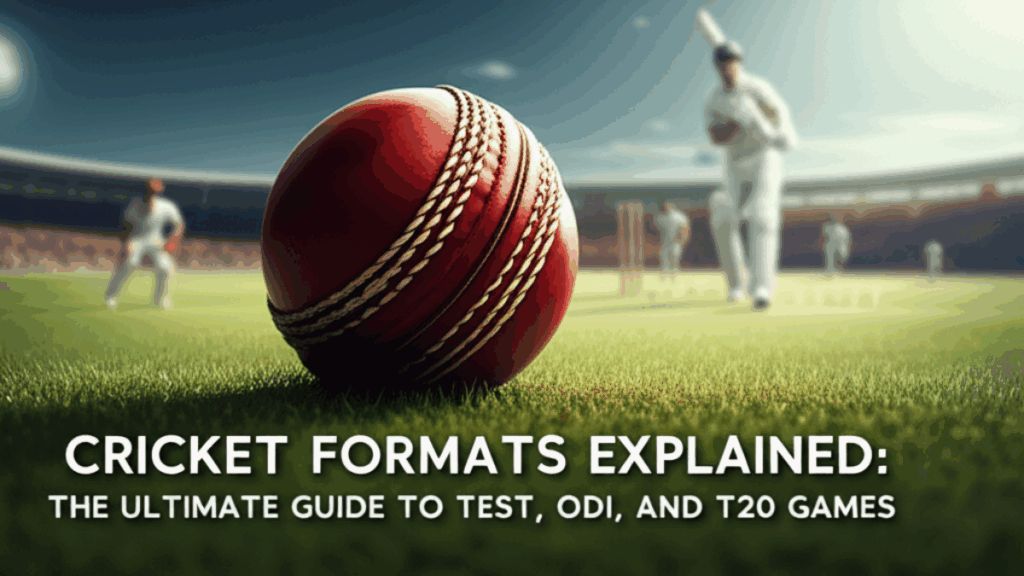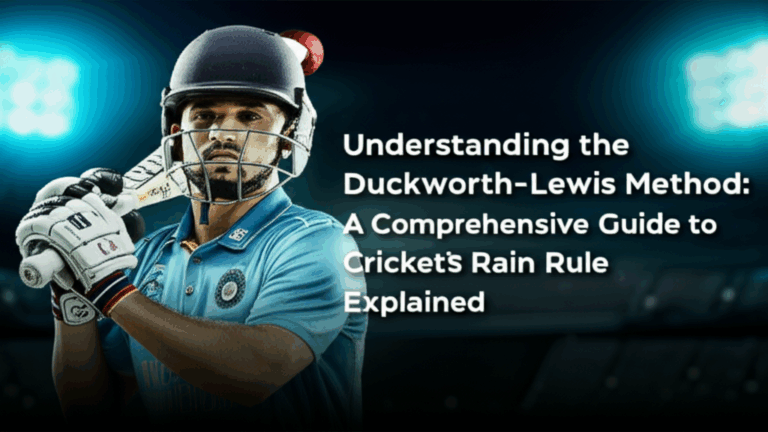
Cricket is more than just a game; it’s a passion that unites millions across the globe. Whether you’re an aspiring player, a seasoned fan, or simply curious about the sport, understanding its various formats is essential. This article dives deep into the three primary formats of cricket: Test matches, One Day Internationals (ODIs), and Twenty20 (T20) games. Each format has its unique charm, rules, and strategies, making cricket a sport of endless intrigue and excitement.
In this ultimate guide, we’ll explore the distinct characteristics of each format, their historical context, and what makes them appealing to players and fans alike. By the end of this article, you’ll have a comprehensive understanding of how these formats differ and how they impact the game’s strategy and viewer engagement. So, whether you’re watching a nail-biting T20 match or a classic Test battle, you’ll appreciate the nuances that make each format special.
Understanding Cricket Formats
Cricket is played in different formats, each with its own rules, duration, and style of play. The three major formats are:
- Test Matches
- One Day Internationals (ODIs)
- Twenty20 (T20) Matches
Each format offers a distinct approach to the game, catering to different audiences and player skills. Let’s break down these formats to understand their unique aspects.
Key Components of Test Matches
What is a Test Match?
A Test match is the longest format of cricket, typically lasting up to five days. Each team bats twice and has the opportunity to bowl twice, allowing for a comprehensive contest of skill, strategy, and endurance.
Duration and Structure
Test matches are played over a maximum of five days, with each day consisting of six hours of play divided into three two-hour sessions. The game is played in two innings per team, and there is no limit to the number of overs a team can bowl in an innings.
Scoring and Strategy
In Tests, runs are scored by batting and running between wickets. The emphasis is on building innings, developing partnerships, and wearing down the opposition. Captains often employ various strategies, such as declaring an innings to set a target or using spin bowlers to exploit the pitch conditions.
Historical Significance
Test matches date back to the 19th century and are considered the pinnacle of cricketing skill. The first-ever Test match was played between Australia and England in 1877. Test cricket has a rich history, featuring legendary players and iconic matches that have shaped the sport.
Key Components of One Day Internationals (ODIs)
What is an ODI?
One Day Internationals (ODIs) are limited-overs matches where each team faces a maximum of 50 overs. This format strikes a balance between the traditional Test matches and the fast-paced T20 games.
Duration and Structure
ODIs typically last around 7-8 hours, including a break between innings. Each team bats for a maximum of 50 overs, with the objective of scoring as many runs as possible. The team with the highest score at the end of the match wins.
Scoring and Strategy
In ODIs, teams prioritize aggressive batting and strategic bowling. Batsmen aim to score quickly, often relying on boundaries and singles. Captains must manage overs wisely, deciding when to unleash their best bowlers and when to conserve energy for later stages of the match.
Historical Context
The ODI format originated in the 1970s, gaining immense popularity with the inaugural Cricket World Cup in 1975. This format has since evolved, showcasing thrilling matches and fostering rivalries that have captivated cricket fans around the world.
Key Components of Twenty20 (T20) Matches
What is T20 Cricket?
T20 cricket is the shortest format, where each team plays a maximum of 20 overs. This format is designed for quick, entertaining matches that often conclude in just a few hours.
Duration and Structure
T20 matches usually last about three hours, making them ideal for spectators looking for a fast-paced experience. Each team has 20 overs to score as many runs as possible, with the match concluding on the same day.
Scoring and Strategy
In T20 cricket, the focus is on explosive batting and aggressive bowling strategies. Batsmen aim to score rapidly, often targeting boundaries, while bowlers try to contain runs and take wickets. The shorter format encourages innovative shots and creative field placements.
Rise in Popularity
Since its inception in the early 2000s, T20 cricket has taken the world by storm. Major leagues like the Indian Premier League (IPL) and international tournaments have contributed to its popularity, attracting a new generation of fans and players.
Benefits and Importance of Each Format
Why Test Matches Matter
Test cricket is often viewed as the ultimate test of a player’s skill and temperament. Here are some key benefits:
- Skill Development: Players develop a wide range of skills, including patience and strategic thinking.
- Historical Value: Tests have a rich history, preserving the game’s traditions and showcasing legendary players.
- Endurance and Teamwork: The format emphasizes physical and mental endurance, fostering teamwork and camaraderie.
Why ODIs are Popular
ODIs provide a thrilling balance between the traditional and modern game. Their benefits include:
- Engaging Format: The limited overs keep audiences engaged while still allowing for strategic play.
- Global Competitions: Tournaments like the Cricket World Cup highlight international rivalries and showcase diverse talent.
- Player Exposure: Players gain international experience, which is crucial for their development.
The Appeal of T20 Matches
T20 cricket has transformed the landscape of cricket with its fast-paced excitement. Here’s why it matters:
- Entertainment Value: The quick format attracts casual fans and is perfect for family outings.
- Financial Impact: Tournaments like the IPL generate significant revenue, benefiting players and organizations.
- Innovation: T20 encourages creativity, leading to the development of new batting techniques and bowling strategies.
Practical Applications of Each Format
How to Enjoy Test Matches
If you’re new to Test cricket, here are some tips to enhance your viewing experience:
- Understand the Rules: Familiarize yourself with the basic rules and structure of Test cricket.
- Watch Historical Matches: Catch classic Test matches to appreciate the strategies employed by legendary players.
- Follow Players: Learn about key players and their skills to enhance your appreciation of the game.
Getting the Most Out of ODIs
To fully enjoy ODIs, consider these suggestions:
- Follow the World Cup: The Cricket World Cup is the pinnacle of ODI cricket; following it can deepen your understanding of international rivalries.
- Engage with Stats: Pay attention to player statistics and team rankings to gauge performance trends.
- Join Discussions: Participate in forums or social media discussions to share insights and opinions with fellow fans.
Maximizing T20 Cricket Enjoyment
Here are ways to enhance your T20 viewing experience:
- Attend Live Matches: If possible, attend T20 matches to enjoy the vibrant atmosphere and excitement.
- Follow Team Leagues: Keep up with domestic leagues like the IPL to see your favorite players in action.
- Embrace the Culture: T20 is not just about cricket; it’s also a cultural event with music, cheerleaders, and a festive atmosphere.
Frequently Asked Questions
What is the primary difference between Test matches and T20 matches?
The primary difference lies in the duration and style of play. Test matches can last up to five days with each team batting twice, while T20 matches last about three hours with each team batting once for a maximum of 20 overs. Test cricket emphasizes skill and strategy, whereas T20 focuses on fast-paced action and entertainment.
Why are Test matches considered the highest form of cricket?
Test matches are regarded as the highest form of cricket due to their length and complexity. They test players’ skills, patience, and strategy over an extended period. Historically, Test cricket has produced some of the greatest players and matches, making it the ultimate showcase of cricketing talent.
How did T20 cricket gain popularity so quickly?
T20 cricket gained rapid popularity due to its fast-paced nature, appealing to a broader audience. The format allows for a complete game in a few hours, making it accessible for casual fans. Major leagues like the IPL have also contributed to its fame, attracting star players and significant viewership.
What strategies should teams employ in ODIs?
In ODIs, teams should focus on building partnerships, aggressive batting, and effective bowling combinations. Captains must manage overs wisely, deciding when to accelerate scoring and when to defend. Understanding pitch conditions and weather factors also plays a crucial role in developing successful strategies.
How can I get involved in cricket?
Getting involved in cricket can start with playing at a local club or school. Watching matches, learning the rules, and following your favorite teams can deepen your connection to the sport. Additionally, joining online forums or local cricket communities can enhance your experience and knowledge.
Conclusion
In conclusion, understanding the various formats of cricket enriches your appreciation of the game. Test matches, ODIs, and T20s each offer unique experiences that cater to different audiences, player skills, and fan engagement. Whether you prefer the strategic depth of Test cricket, the excitement of ODIs, or the fast-paced thrills of T20, there’s something for everyone in cricket.
As you explore the world of cricket, remember to embrace the history, strategies, and cultural impact of each format. So, grab your gear or settle in for a match—there’s a whole universe of cricket waiting for you. Let’s celebrate this incredible sport together!




